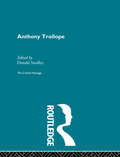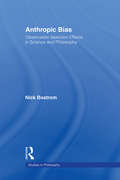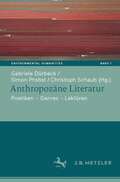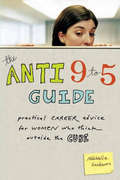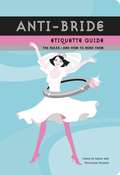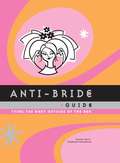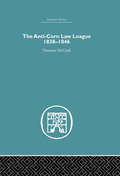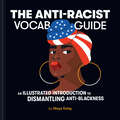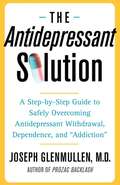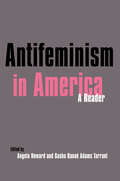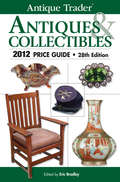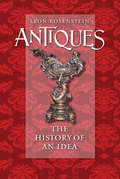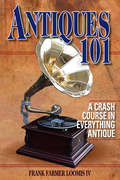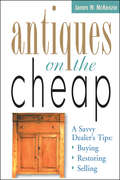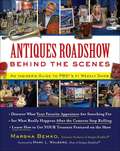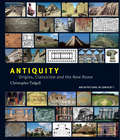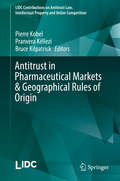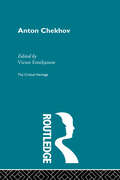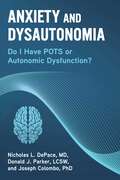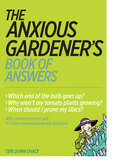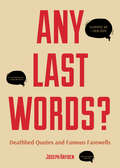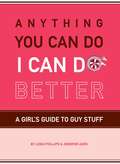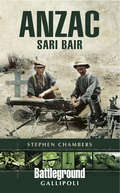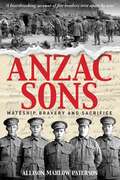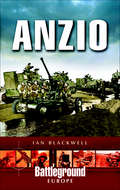- Table View
- List View
Anthony Trollope: The Critical Heritage (Critical Heritage Ser.)
by Donald SmalleyFirst Published in 1995. Routledge is an imprint of Taylor & Francis, an informa company.
Anthropic Bias: Observation Selection Effects in Science and Philosophy
by Nick BostromAnthropic Bias explores how to reason when you suspect that your evidence is biased by "observation selection effects"--that is, evidence that has been filtered by the precondition that there be some suitably positioned observer to "have" the evidence. This conundrum--sometimes alluded to as "the anthropic principle," "self-locating belief," or "indexical information"--turns out to be a surprisingly perplexing and intellectually stimulating challenge, one abounding with important implications for many areas in science and philosophy. There are the philosophical thought experiments and paradoxes: the Doomsday Argument; Sleeping Beauty; the Presumptuous Philosopher; Adam & Eve; the Absent-Minded Driver; the Shooting Room. And there are the applications in contemporary science: cosmology ("How many universes are there?", "Why does the universe appear fine-tuned for life?"); evolutionary theory ("How improbable was the evolution of intelligent life on our planet?"); the problem of time's arrow ("Can it be given a thermodynamic explanation?"); quantum physics ("How can the many-worlds theory be tested?"); game-theory problems with imperfect recall ("How to model them?"); even traffic analysis ("Why is the 'next lane' faster?"). Anthropic Bias argues that the same principles are at work across all these domains. And it offers a synthesis: a mathematically explicit theory of observation selection effects that attempts to meet scientific needs while steering clear of philosophical paradox.
Anthropozäne Literatur: Poetiken – Themen – Lektüren (Environmental Humanities #1)
by Gabriele Dürbeck Simon Probst Christoph SchaubDer sich seit 2000 etablierende Anthropozän-Diskurs begreift die Menschheit als geophysikalische Kraft. Wesentliche Strukturmerkmale dieses Diskurses und seiner Narrative sind das Einnehmen einer planetarischen Perspektive auf die globale Umweltkrise, eine tiefenzeitlich konstituierte Historizität, die Annahme unauflösbarer Wechselbeziehungen von Natur und Kultur und das Thematisieren ethischer Verantwortung des Menschen für das Erdsystem. Die literaturwissenschaftliche Forschung hat in den letzten Jahren das Anthropozän als geologisches sowie kulturelles Konzept aufgenommen und spricht zunehmend häufiger von ‚anthropozäner‘ Literatur. Der vorliegende Band mit 15 Beiträgen und einer Einleitung, die das Feld erstmals vermisst, stellt einen innovativen Versuch in der deutschsprachigen Forschungslandschaft dar, Ansätze zusammenzutragen, die die Rede von einer Anthropozän-Literatur in diesem entstehenden Forschungsfeld präzisieren, systematisieren und kritisch befragen. Dabei geht es um mögliche Poetiken und Genres. In Fallstudien (‚Lektüren‘) werden mögliche anthropozäne Lesarten ausprobiert.
The Anti 9 to 5 Guide: Practical Career Advice for Women Who Think Outside the Cube
by Michelle GoodmanToday, lots of women would love to integrate their passion with their career and are seeking advice on how to do just that. Michelle Goodman, a self proclaimed, "wage-slave" has written a fun, reassuring, girlfriend-to-girlfriend guide on identifying your passion, transitioning out of that unfulfilling job, and doing it all in a smart, practical way. The Anti 9-to-5 Guide realizes that not every woman wants the corner office, in fact, some women don't want to be in an office at all. Today's women are non-traditionalists, do it yourself sort of girls who want to travel the world, take up knitting, frolic in the land of freelancing but want to do it all without going broke. The Anti 9-to-5 Guide provides readers with the resources you need to have it all and still have a place to sleep. Michelle suggests great tips for easing into the life you want. With an entire chapter devoted to pursuing your passion on the side, The Anti 9-to-5 Guide encourages us to tweak our current career path or head down a new one, and ultimately succeed.
Anti-Bride Etiquette Guide
by Kathleen Hughes Carolyn GerinFollowing the best-selling Anti-Bride Guide and Bridesmaid's Guide down the aisle comes the essential, smart, and sassy etiquette guide for the not-so-traditional bride. This feisty and straightforward advice book fills a huge gap in the wedding etiquette market. A riot to read and packed with bold illustrations, it walks the bride through everything from invitations and seating arrangements to money matters and family feuds. Whether fielding classic conundrumswho pays for whator decidedly modern situationsthe maid of honor is a manAnti-Bride Etiquette Guide offers sensitive advice for skillfully navigating the rough spots. Inventive solutions for dodging outmoded traditions ensure that brides will keep everyone from grooms to grandmothers happy. For the bride who doesn't want to sacrifice the wedding of her dreams or her loved ones' feelings, Anti-Bride Etiquette Guide has the answers.
Anti-Bride Guide
by Stephanie Rosenbaum Carolyn GerinInto a sea of pearl white and pale blue comes the hot pink and orange Anti-Bride Guide. The perfect book for anyone alienated by the high-brow wedding industry, this practical guide fills a huge gap in the wedding planner market. A riot to read and filled with sassy illustrations, each chapter offers up fabulous advice and unusual ideas for those brides looking for more than the standard fare. Hundreds of fantastic tips give great insider advice on how to deal with any and all wedding eventualities (lipstick stain on dress, caterer from hell, wedding day breakout). A handy planner and resource guide keeps the bride on track, and tabbed chapters have pockets for stuffing brochures and clippings. For the bride who wants her wedding her way, this is the ultimate guide.
The Anti-Corn Law League: 1838-1846
by Norman McCordAlthough the Anti-Corn Law league played a most important part in the politics of the 1840's, there is no modern study of its activities and organization. Based on several years work on the original sources, as well as papers belonging to George Wilson, President of the League for most of its life, this book sheds light on the internal history and organization of the League. Written from a political perspective, Dr McCord describes the origin, organization and activities of the League, together with its effect on the contemporary political scene, and as such, fills an important gap in our knowledge of the political history of early Victorian England. At the same time, the book provides an analysis of an unusually well-documented political pressure group, making it a most welcome addition to literature for historians and economic historians, as well as students of political science. This book was first published in 1958.
Anti-Racist Vocab Guide: An Illustrated Introduction to Dismantling Anti-Blackness
by Maya EaleyFrom "Assimilation" to "Decolonization," "Black Wall Street" to "Police Brutality," and "Colorism" to "White Supremacy," this book equips you with the language to engage in crucial conversations around anti-Black racism.The Anti-Racist Vocab Guide is a boldly illustrated visual glossary that distills complex subjects into comprehensive yet accessible definitions of terms and provides concise and insightful explanations of historical moments. With reflection questions to use for introspection or as a starting point for hard conversations with those close to you, this book will encourage both your learning and unlearning—no matter where you are in your journey to understanding race in America.THOROUGH AND APPROACHABLE: This book presents huge topics in easy-to-understand language that welcomes readers of every experience.REFLECTION QUESTIONS: Each entry is followed by questions to encourage readers to continue their education and translate their new understanding into positive action in their daily lives.BEYOND THE BUZZWORDS: This is an invaluable resource guide that breaks down and goes beyond common phrases to provide actionable awareness.EVOCATIVE ART: Author Maya Ealey's striking art provides conceptual illustrations of each term explained in the book in her bold, passionate style.Perfect for:Anyone interested in learning more about race in AmericaPeople who want help understanding the complicated subject of racismParents, teachers, and studentsReaders of instructive and informative best sellers such as How to Be an Antiracist, White Fragility, The 1619 Project, and Do the Work!: An Antiracist Activity Book
The Antidepressant Solution
by Joseph GlenmullenWith the FDA's warning that antidepressants may cause agitation, anxiety, hostility, and even violent or suicidal tendencies, these medications are at the forefront of national legal news. Harvard physician Joseph Glenmullen has led the charge to warn the public that antidepressants are overprescribed, underregulated, and, especially, misunderstood in their side and withdrawal effects. Now he offers a solution! More than twenty million Americans -- including over one million teens and children -- take one of today's popular antidepressants, such as Paxil, Zoloft, or Effexor. Dr. Glenmullen recognizes the many benefits of antidepressants and prescribes them to his patients, but he is also committed to warning the public of the dangers associated with overprescription. Dr. Glenmullen's last book, Prozac Backlash, sounded the alarm about possible dangers. The Antidepressant Solution provides the remedy. It is the first book to call attention to the drugs' catch-22: Although many people are ready to go off these drugs, they continue to take them because either the patient or the doctor mistakes antidepressant withdrawal for depressive relapse. The Antidepressant Solution offers an easy, step-by-step guide for patients and their doctors. Written by the premier authority in the field, The Antidepressant Solution is an invaluable book for all those concerned with going through the process -- from friends and family members to doctors and patients themselves.
Antifeminism in America: A Historical Reader (Antifeminism In America: A Collection Of Readings From The Literature Of The Opponents To U. S. Feminism, 1848 To The Present Ser. #2)
by Gillian SwansonThe documents in this paperback inform the reader's understanding and appreciation of the social and political context of opposition in which the advocates of women's rights labored from 1848 to 1996. Arranged in six parts by historical periods, these original articles from mainstream magazines, specialized and academic journals, and books display the tone and substance of opposition to women's rights as it appeared in popular literature. The selections reflect the public campaign, fought in the popular press, of opponents to the fundamental goal of all aspects of movement for women's rights, to challenge the gender system by advocating equality for women.
Antique Trader Antiques & Collectibles 2012 Price Guide (Antique Trader)
by Eric BradleyAmerica's No. 1 Selling Price Guide For nearly 30 years, Antique Trader Antiques & Collectibles has been the leading source for information on antiques and collectibles. Filled with expert advice, vetted values and 4,500 color photographs, Antique Trader provides the clearest and most dependable picture of this amazingly diverse and magnificent market. Inside you will enjoy a variety of new collecting areas, as well as old favorites. Including: Asian art, bottles, ceramics, Civil War collectibles, clocks, comic books, cookie jars, figurines, furniture, glass, Hallmark Keepsake Ornaments, illustration art, kitchenware, perfume bottles, petroliana, toys, vintage clothing and Zippo lighters. Also new this year is Top Lots, a feature highlighting the bestselling results from some of the finest auction houses nationwide.
Antiques: The History of an Idea
by Leon RosensteinThe notion of retrieving a bit of the past-by owning a material piece of it-has always appealed to humans. Often our most prized possessions are those that have had a long history before they came into our hands. Part of the pleasure we gain from the encounter with antiques stems from the palpable age and the assumed (sometimes imaginary) cultural resonances of the particular object. But precisely what is it about these objects that creates this attraction? What common characteristics do they share and why and how do these traits affect us as they do? In Antiques: The History of an Idea, Leon Rosenstein, a distinguished philosopher who has also been an antiques dealer for more than twenty years, offers a sweeping and lively account of the origin and development of the antique as both a cultural concept and an aesthetic category. He shows that the appeal of antiques is multifaceted: it concerns their value as commodities, their age and historical and cultural associations, their uniqueness, their sensuous and tactile values, their beauty. Exploring how the idea of antiques evolved over time, Rosenstein chronicles the history of antique collecting and connoisseurship. He describes changing conceptions of the past in different epochs as evidenced by preservations, restorations, and renascences; examines shifting attitudes toward foreign cultures as revealed in stylistic borrowings and the importation of artifacts; and investigates varying understandings of and meanings assigned to their traits and functions as historical objects.While relying on the past for his evidence, Rosenstein approaches antiques from an entirely original perspective, setting history within a philosophical framework. He begins by providing a working definition of antiques that distinguishes them from other artifacts in general and, more distinctly, both from works of fine art and from the collectible detritus of popular culture. He then establishes a novel set of criteria for determining when an artifact is an antique: ten traits that an object must possess in order to elicit the aesthetic response that is unique to antiques. Concluding with a provocative discussion of the relation between antiques and civilization, this engaging and thought-provoking book helps explain the enduring appeal of owning a piece of the past.
Antiques 101: A Crash Course in Everything Antique
by Frank Farmer Loomis IVMaster Antique Styles Painlessly Not sure how to tell Chippendale from Queen Anne, or Art Deco from Art Nouveau? Learn the easy way with the author's entertaining style. Frank Farmer Loomis IV is an expert communicator who knows how to engage students with anecdotes and humor. If you're looking for clear, simple explanations rather than unpronounceable terms like corbeille a fleurs (flower basket) or sang de boeuf (red glaze), you've come to the right place, as he will "demystify all the perplexing twaddle" for you. And while you're learning, discover your antiquing personality and how antiquing can reduce stress. A User-Friendly Reference for Antiquers Master 16 major antique furniture styles and the six main woods Use furniture styles to identify and date other antiques Learn the various types of china, silver, pewter, and their marks
Antiques on the Cheap: A Savvy Dealer's Tips: Buying, Restoring, Selling
by James W. McKenzieGet the inside scoop on every aspect of antiquing - buying, cleaning, repairing, embellishing, refinishing, restoring, and selling. You'll find expert advice for getting great deals at auctions, flea markets, and shops, and you'll learn how to spot items that can be repaired to increase their value. Advice for selling antiques at flea markets, on consignment, and in shops is included.
Antiques Roadshow Behind the Scenes
by Marsha Bemko Mark L WalbergAn all-access pass to America's first (and favorite) reality television program -- boasting over ten million viewers each week -- Antiques Roadshow! If you're a fan of PBS's top-rated Antiques Roadshow, you've probably wondered -- what would it take to get your family treasure on the program? What happens to the antiques after the show airs? Are the appraisers ever wrong? And will Antiques Roadshow come to my hometown? In this four-color, fully illustrated guide to America's favorite treasure-hunting program, Antiques Roadshow Behind the Scenes reveals inside information about the participants, the appraisers, the fans, and the antiques that make up the show, direct from the woman who makes it all happen -- executive producer Marsha Bemko. Learn what it really takes to put on a Roadshow event (and why certain cities are more likely to get a visit from the show than others), who gets chosen to be on air (and what items producers are really looking for), what it takes to be an appraiser (and how even the experts make mistakes) ... and what happens when things go terribly wrong (such as the occasional antique that turns out to have been stolen!). In addition, learn which books, websites, and resources your favorite appraisers recommend, and get updates on some of the most popular and notorious items ever featured on the show. From priceless tips to the juicy family secrets hidden in dusty heirlooms, Antiques Roadshow Behind the Scenes is both an invaluable resource and a fascinating slice of Americana.
Antiquity: Origins, Classicism and The New Rome
by Christopher TadgellThe first in a new series of five books describing and illustrating the seminal architectural traditions of the world, Antiquity traces architectural history from its very beginnings until the time when the traditions that shape today’s environments began to flourish. More than a catalogue of buildings, in this work Tadgell provides their political, technological, social and cultural contexts and explores architecture, not only as the development of form and space but as an expression of the civilization within which it evolves. The buildings are analyzed and illustrated with over 1200 colour photographs and 400 drawings while the societies that produced them are brought to life through a broad selection of their artefacts.
Antitrust in Pharmaceutical Markets & Geographical Rules of Origin (LIDC Contributions on Antitrust Law, Intellectual Property and Unfair Competition)
by Bruce Kilpatrick Pierre Kobel Pranvera KëlleziThis book gathers international and national reports from across the globe on key questions in the field of antitrust and intellectual property. The first part discusses the application of competition law in the pharmaceutical sector, which continues to be a focus for anti-trust authorities around the world. A detailed international report explores the extent to which the application of the competition rules in the pharmaceutical sector should be affected by the specific characteristics of those products and markets (including consumer protection rules, the need to promote innovation, the need to protect public budgets, and other public interest considerations). It provides an excellent comparative study of this complex subject, which lies at the interface between competition law and intellectual property law. The second part of the book gathers contributions from various jurisdictions on the topic of "What rules should govern claims by suppliers about the national or geographic origin of their goods or services?" This section presents an international report, which offers an unparalleled comparative analysis of this topic, bringing together common themes and contrasting the various national provisions dealing with indications of origin, amongst other things. The book also includes the resolutions passed by the General Assembly of the International League of Competition Law (LIDC) following a debate on each of these topics, which include proposed solutions and recommendations. The LIDC is a long-standing international association that focuses on the interface between competition law and intellectual property law, including unfair competition issues.
Anton Chekhov
by Victor EmeljanowThis set comprises forty volumes covering nineteenth and twentieth century European and American authors. These volumes will be available as a complete set, mini boxed sets (by theme) or as individual volumes. This second set compliments the first sixty-eight volume set of Critical Heritage published by Routledge in October 1995.
Anxiety and Dysautonomia: Do I Have POTS or Autonomic Dysfunction?
by Nicholas L. DePace Joseph Colombo Donald J. ParkerWhat causes anxiety to be so prevalent in so many people? How is it best prevented and treated? What can patients and physicians do to better understand this common medical issue? Anxiety is a component of many physical and mental disorders, from depression to PTSD. Unfortunately, not many patients find relief in the associated therapies and medications, and simply adding more of the same often causes other disorders. Additionally, many who suffer from anxiety may in fact have other, anxiety-like conditions, such as the frequently misdiagnosed postural orthostatic tachycardia syndrome (POTS), which can make any attempt at treatment futile. But now, with Anxiety and Dysautonomia: Do I Have POTS or Autonomic Dysfunction?, Donald J. Parker and physicians Joseph Colombo and Nicholas L. DePace aim to show, with a simplified analysis and discussion focusing on this common patient complaint and how best to treat it, that no longer does anxiety need to be merely managed with the forced lifestyle changes that are often required. Topics covered include: Parasympathetic and Sympathetic (P&S) dysfunctions that lead to anxiety-like conditions, plus clear concepts of anxiety and anxiety-like symptoms, the six-pronged Mind-Body Wellness Program, and the P&S nervous systems. How many of these anxiety-like conditions are actually caused by a lack of proper blood flow to the brain, which may cause mild symptoms of depression, fatigue, malaise, brain fog, and cognitive and memory difficulties, sleep difficulties, and more. The way these issues, when exacerbated, may trigger &“adrenaline storms&” that cycle the anxiety-like symptoms. Treatments that in many cases enable a return to a &“normal&” (as defined by the patient) quality of life, including natural therapies to relieve symptoms and promote wellness. Presenting discussions with patients and doctors side-by-side to help physicians see how to present information to their patients and patients to learn what physicians need to know to tailor therapy to their individual needs, Anxiety and Dysautonomia is an essential resource for anyone concerned with anxiety and anxiety-like disorders, from medical professionals to patients to family and friends.
The Anxious Gardener's Book of Answers
by Teri Dunn ChaceThe Anxious Gardener's Book of Answers identifies the 100 most common gardening mistakes and gives gardeners the techniques to prevent them. Or, if it's too late and they've already goofed, there are tips to fix the mistake. The book's 24 chapters tackle every kind of gardening disaster, whether it has to do with plants, tools and techniques, or general care and maintenance. Gardeners looking to prune their roses will learn to hold off until late winter to avoid damaging plant tissue. Gardeners that have allowed their mint to overgrow? Dunn advises pulling it out and replanting it in a container to control the root. Organized by common garden topics and designed to be easily dipped in and out of, The Anxious Gardener's Book of Answers offers nuggets of wisdom based on Teri Dunn Chace's years of hands-on gardening experience. Advice is humorously supported by Colleen Coover's delightful illustrations. This accessible guide will transform an anxious gardener into an informed, confident, successful gardener with a mistake-free garden
Any Last Words?: Deathbed Quotes and Famous Farewells
by Joseph Hayden#1 New Release in Reference & Collections - Last Words of Famous and Infamous PeopleAn Insightful and humorous look into the stories behind the words. From heartwarming, to sad, to straight up quirky, Any Last Words? shares insight from the world’s most interesting figures through the lens of their final words and last moments.Adult and teen gifts for all occasions. If you’re looking for the best gifts for men and women who have everything, you can’t go wrong with the gift of fun facts, inspiration, and wisdom. The last words of some of the most important people in history are great gifts for teens, graduations, or milestone birthdays.Conversation starters and fun facts. Any Last Words? is a great addition to any collection of coffee table books or humor books. Learn and share fun facts about celebrities in the worlds of film, music, art, athletics, literature, politics and more. The quotes in Any Last Words? offer a rare glimpse into the lives of people who left their mark on the world.Any Last Words? celebrates the lives and last words of inspiring and important figures, including:AthletesPoliticiansMusiciansArtistsScientistsCriminalsAny Last Words? is perfect for anyone who appreciates funny and weird gifts. Readers who like The Big Book of Quotes, Lend Me Your Ears, and Movie Quotes for All Occasions will find hours of entertainment in Any Last Words?: Deathbed Quotes and Famous Farewells.
Anything You Can Do, I Can Do Better
by Leigh Phillips Jennifer AxenLadies: Are you sick of sitting on the bench while the men in your life talk Fantasy Football? Have you always wanted to know how to kick down a door? Build a fire? For any gal who's ready to go head-to-head with the guys on their own turf this book is brimming with sassy, do-it-yourself style. It's chock-full of instructions on the manliest of manly arts, from the highbrow (know the difference between single malt and blended whiskey), to the lowbrow (learn to spit farther than a trucker). Authors Jennifer Axen and Leigh Phillips have written this comprehensive, how-to manual for all the smart, capable women who are sick and tired of being laughed at for not knowing which way is North, intimidated by the finer points of grilling, or just plain excluded for not knowing the (let's face it, very convoluted) infield fly rule. So, for the women out there who know they can do it betterjust as soon as they learn howhelp is finally at hand!
Anzac: Sari Bair (Battleground Gallipoli)
by Stephen ChambersThe August Offensive was born out of the failures of the Gallipoli landings and the subsequent battles of late spring and early summer 1915. General Sir Ian Hamilton, Commander-in-Chief of the Mediterranean Expeditionary Force, chose to play all his remaining cards in this daring and ingenious gamble that he hoped would finally turn the tide in the allies favour and bring his army up onto the heights overlooking the elusive Dardanelles. However the plan's same ingenuity became its eventual undoing. It required complex manoeuvring in tortuous terrain; whilst many of the attacking soldiers were already weakened by the hardships of four months of enduring very poor conditions on the Peninsula. What played out was heartbreakingly tragic; command failed the bravery and sacrifice of the fighting soldier. This Anzac offensive, fought by a combined force of British, Australian, New Zealand and Indian troops, made infamous places such as Lone Pine, The Nek, Sari Bair, Chunuk Bair, Hill Q, The Farm, Hill 971 and Hill 60. Although tantalisingly close to success, the offensive fell short of its objectives and the attack was ground down to a stalemate - not least the consequence of the inspiring leadership of Mustafa Kemal. Hamilton's gamble had failed. This is the story, told using a rich mix of letters, diaries, photographs and maps, of Gallipoli's last battles; the forlorn hope for a decisive victory.As featured in the West Sussex County Times and All About Horsham Magazine.
Anzac Sons: Mateship, Bravery and Sacrifice
by Allison Paterson…Well dear Jim it breaks my heart to write this letter. Our dear [brother] was killed yesterday morning at 5.30. The bullet killed him instantly and he never spoke a word. I had just left him and gone down the trench to see the other lads when I was called back. Oh Jim it is awful … Oh I do hope he is the last … It is April 27, 1918, Jim&’s brother writes from the battlefields of France. Of five brothers serving on the Western Front, three have given their lives; another has been hospitalized. Six agonizing months of brutal warfare were yet to be endured … World War I was a senseless tragedy. Its long shadow darkened the four corners of the world. In Mologa, Victoria, once a bustling community, stands a lonely stone memorial. Etched within the granite are the names of the Marlow brothers and their mates; a testament to ordinary people who became heroes. Anzac Sons is composed from a collection of over 500 letters and postcards written by the brothers who served. From the training grounds of Victoria, Egypt and England, to the Western Front battlefields – Pozieres, Bullecourt, Messines, Menin Road, Passchendaele, Villers-Bretonneux and the battles of 1918 – this compelling true story was compiled by the granddaughter of a surviving brother. She takes us on her journey as she walks in the footsteps of her ancestors.This is a story of mateship, bravery and sacrifice; it is a heartbreaking account of a family torn apart by war. It is a pledge to never forget.
Anzio: Italy 1944 (Battleground Europe)
by Ian BlackwellIn an attempt to outflank the German Gustav Line running across Italy, Operation SHINGLE was launched on January 22nd 1944. Achieving complete surprise, the Allies made a successful landing at Anzio, but paused rather than pushing quickly inland, a delay which gave the Germans time to seal off the area and to counterattack the beachhead. Heavy fighting took place until early March, during which the Americans and British were nearly driven into the sea, after which a stalemate was reached. In the following months the Allied forces were reinforced and in late May a breakout was made with the strategic intention of cutting off the Germans retreating from the Gustav line, which had now been pierced. However, General Mark Clark redirected the main effort of the Anzio forces towards the capture of Rome, permitting most of the enemy to escape and to fight another day. An operation that cost thousands of lives for disputed benefits, SHINGLE remains a controversial subject.
